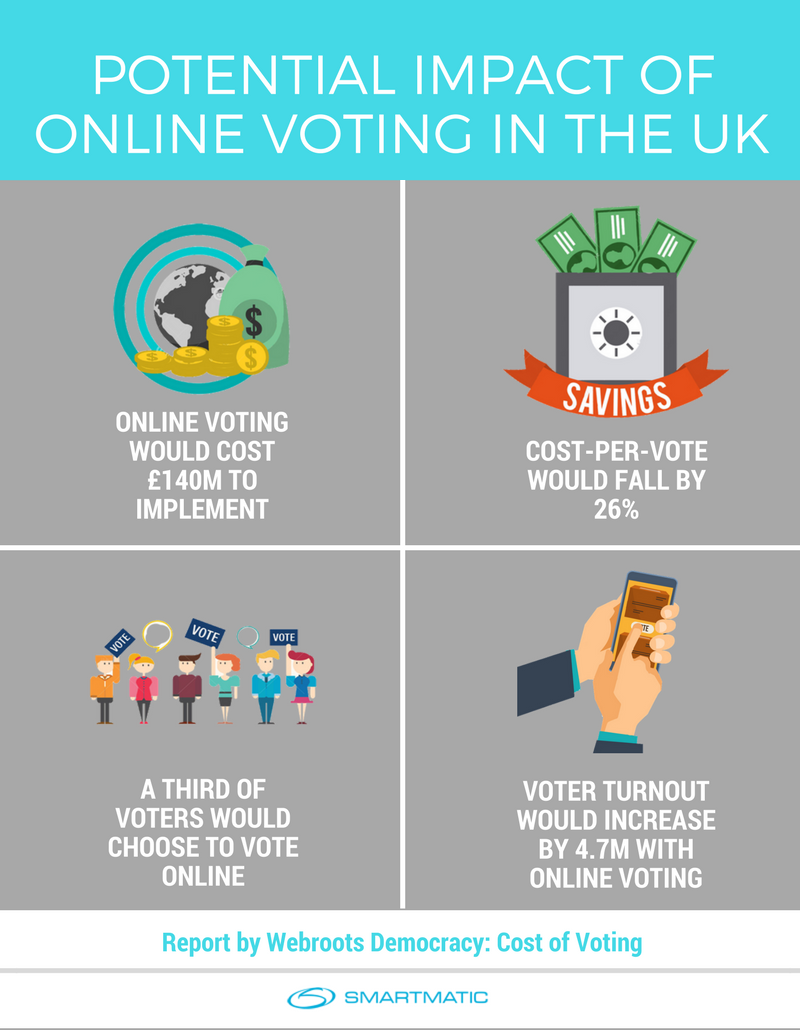The London-based think tank WebRoots Democracy recently published a report on the Cost of Voting in the UK
The study focuses on estimating the cost of online voting and its potential impact on voter turnout and on election administration expenses; as well as offering significant recommendations to the Government in advance of the 2022 UK General Election.
Why is the report relevant and timely appropriate?
- Shares key findings of a complex issue despite the difficult-to-gather data. Among the most optimistic discoveries are:
- The cost-per-vote with online voting would rise to £7.03 in the first national election and fall to £2.76 in subsequent elections, reducing the cost-per-vote by 26%.
- Online voting could increase voter turnout by 4.7m to 79%. If introduced as an option, the proportion of people voting at a polling station would fall from 78% to 38%, 33% would choose to vote online, and 21% by post.
- Online voting has a higher preference amongst female respondents (34%) compared to male respondents (32%). This follows a trend across many of the opinion polls undertaken on online voting in recent years.
- Amongst 18 to 50-year-old respondents, voting online is the most preferred method of voting compared to in-person and postal. Amongst this age range, 40% chose online voting as their preferred method.
- Online voting would reduce the overall length of the vote count by 3.5 hours.
- Sets a precedent for future studies, offers expenditure data available to compare with, and it encourages election’s stakeholders to collect and reveal their figures and analysis.
- The implementation of online voting would cost an estimated £140m for the implementation phase, followed by £6m for each subsequent election. The first national election with online voting would cost £260m to administer. Following national votes would then require an estimated £102m.
- The current highest costs involved with administering elections are: staffing polling stations (£18.5m) and printing and distributing poll cards (£10.7m). Followed by hiring polling stations (£8m); counting ballot papers (£6.3m); distributing postal votes (£6.2m); printing ballot papers (£4m); and processing postal votes (£3m).
- “The move away from paper-based methods of voting could lead to significant reductions in the variable costs associated with paper-based voting. Before taking into account the costs of introducing online voting, costs are already down by 37%.”

- Makes a well-supported case for piloting online voting. It presents technical, political and practical arguments, as well as it explains some cost-effective extra benefits.
- It considers the research, experiences, and data available from other countries. The report presents, for example, the Australian and Estonian cases.
- Analyse new cost considerations that would come into play with the introduction of online voting. “Architecture and design of the system, identity authentication, professional hackers to test the system for weaknesses, network flood defences, technical support, training for staff, a monitoring system, public education campaigns, emergency response team to deal with potential attacks.”
- It contextualises it against similar digital transformation projects in the UK, mainly the introduction of online voter registration. “The same requirements of strong cyber-security defences, safe internet use, and trust in the system exists for online voter registration as it would for online voting.”
- A key benefit of the introduction of online voting is the potential it has to increase overall voter turnout. “For particular sections of society such as voters with vision impairments and disabilities, or voters based overseas, it is clear to see how an accessible, remote online voting system would boost participation at elections.”
- Proposes simple, direct and pragmatic recommendations, for election’s authorities pondering the option of online voting.
- The Government should consider pilot an online voting option before the 2022 General Election and evaluate the potential of opt-in electronic poll cards.
- Election management officers should publish their own analysis of how much they consider online voting would cost to introduce.
- Election expenditure should be as transparent, detailed and publicly available as possible.
- The Government should adopt email collection at voter registration as mandatory.
If you have not read the complete report yet, it is probably a good time to enjoy it. We are proud to have our colleague Mike Summers, Smartmatic’s Manager Program, as part of the experts supporting this Webroots’ initiative and its subsequent launching event in the House of Commons (London, November 2017).